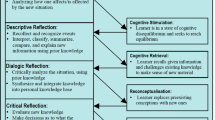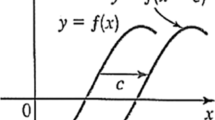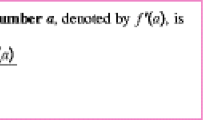Abstract
In this paper I report a lengthy episode from a teaching experiment in which 15 Year 12 Greek students negotiated their definitions of tangent line to a function graph. The experiment was designed for the purpose of introducing students to the notion of derivative and to the general case of tangent to a function graph. Its design was based on previous research results on students’ perspectives on tangency, especially in their transition from Geometry to Analysis. In this experiment an instructional example space of functions was used in an electronic environment utilising Dynamic Geometry software with Function Grapher tools. Following the Vygotskian approach according to which students’ knowledge develops in specific social and cultural contexts, students’ construction of the meaning of tangent line was observed in the classroom throughout the experiment. The analysis of the classroom data collected during the experiment focused on the evolution of students’ personal meanings about tangent line of function graph in relation to: the electronic environment; the pre-prepared as well as spontaneous examples; students’ engagement in classroom discussion; and, the role of researcher as a teacher. The analysis indicated that the evolution of students’ meanings towards a more sophisticated understanding of tangency was not linear. Also it was interrelated with the evolution of the meaning they had about the inscriptions in the electronic environment; the instructional example space; the classroom discussion; and, the role of the teacher.







Similar content being viewed by others
Notes
We call inflection point of a function graph, a point in which the concavity of the curve changes and there is a tangent line at this point; edge point a point in which the function is continuous and the derivative from the left and the right exist without being equal; and, cusp point a point in which the function is continuous and the limit of the rate of change from the left and the right is infinite.
References
Artigue, M., Batanero, C., & Kent, P. (2007). Mathematics thinking and learning at post-secondary level. In F. K. Lester (Ed.), The second handbook of research on mathematics teaching and learning (pp. 1011–1049). USA: NCTM.
Bartolini-Bussi, M. G. (1996). Mathematical discussion and perspective drawing in primary school. Educational Studies in Mathematics, 31(1–2), 11–41.
Bell, A. (1993). Some experiments in diagnostic teaching. Educational Studies in Mathematics, 24(1), 115–137.
Berger, M. (2004). The functional use of a mathematical sign. Educational Studies in Mathematics, 55(1–3), 81–102.
Biza, I. (2008). Students’ intuitive perspectives on the tangent line in the context of analysis. Unpublished PhD in Mathematics Education, University of Athens, Athens, Greece.
Biza, I. (2010). Evolution of mathematical discourse with the mediation of electronic environment: The case of tangent line. Paper presented at the Proceedings of the 13th Special Interest Group of the Mathematical Association of America (SIGMAA) Conference on Research in Undergraduate Mathematics Education (RUME). From http://sigmaa.maa.org/rume/crume2010/Archive/Biza.pdf.
Biza, I., Christou, C., & Zachariades, T. (2008). Student perspectives on the relationship between a curve and its tangent in the transition from Euclidean Geometry to Analysis. Research in Mathematics Education, 10(1), 53–70.
Biza, I., Diakoumopoulos, D., & Souyoul, A. (2007). Teaching analysis in dynamic geometry environments. In D. Pitta-Pantazi & G. Philippou (Eds.), Proceedings of the 5th conference of European research in mathematics education (pp. 1359–1368). Larnaca, Cyprus. Available at: http://ermeweb.free.fr/CERME5b/WG9.pdf.
Biza, I., & Zachariades, T. (2010). First year mathematics undergraduates’ settled images of tangent line. The Journal of Mathematical Behavior, 29(4), 218–229.
Castela, C. (1995). Apprendre avec et contre ses connaissances antérieures: Un example concret, celui de la tangente. Recherches en Didactiques des mathématiques, 15(1), 7–47.
Clandinin, D. J., & Conelly, F. M. (2000). Chapter 7: Composing field texts. Narrative inquire in story in qualitative research (pp. 92–118). San Francisco, CA: Jossey-Bass.
EucliDraw. (2009). Retrieved 3 October, 2009, from http://www.euclidraw.com.
Habre, S., & Abboud, M. (2006). Students’ conceptual understanding of a function and its derivative in an experimental calculus course. The Journal of Mathematical Behavior, 25(1), 57–72.
Harel, G., Selden, A., & Selden, J. (2006). Advanced mathematical thinking. Some PME perspectives. In A. Gutierrez & P. Boero (Eds.), Handbook of research on the psychology of mathematics education: Past, present and future (pp. 147–172). Rotterdam, The Netherlands: Sense Publishers.
Kaput, J. (1994). Democratizing acess to calculus: New roots to old roots. In A. Schoenfeld (Ed.), Mathematical thinking and problem solving (pp. 77–156). Hillsdale, NJ: Lawrence Erlbaum.
Lagrange, J. B. (1999). Complex calculators in the classroom: Theoretical and practical reflections on teaching pre-calculus. International Journal of Computers for Mathematical Learning, 4(1), 51–81.
Lakatos, I. (1976). Proofs and refutations: The logic of mathematical discovery. Cambridge, UK: Cambridge University Press.
Mariotti, M. A. (2001). Justifying and proving in the cabri environment. International Journal of Computers for Mathematical Learning, 6(3), 257–281.
Maschietto, M. (2008). Graphic calculators and micro-straightness: Analysis of a didactic engineering. International Journal of Computers for Mathematical Learning, 13(3), 207–230.
Noss, R., & Hoyles, C. (1996). Windows on mathematical meanings. Dordrecht, The Netherlands: Kluwer Academic Publishers.
Presmeg, N. C. (2006). Research on visualization in learning and teaching mathematics. In A. Gutierrez & P. Boero (Eds.), Handbook of research on the psychology of mathematics education: Past, present and future (pp. 205–235). Rotterdam, The Netherlands: Sense Publishers.
Steffe, P., & Thompson, P. (2000). Teaching experiment methodology: Underlying principles and essential elements. In A. E. Kelley & R. Lesh (Eds.), Handbook of research design in mathematics and science education (pp. 267–306). Mahwah, NJ: Erlbaum.
Tall, D. O. (1987). Constructing the concept image of a tangent. In J. C. Bergeron, N. Herscovics & C. Kieran (Eds.), Proceedings of the 11th conference of the international group for the psychology of mathematics education (Vol. 3, pp. 69–75). Montréal, Canada.
Tall, D. O. (1989). Concept images, generic organizers, computers and curriculum change. For the Learning of Mathematics, 9(3), 37–42.
Tall, D. O., Smith, D., & Piez, C. (2008). Technology and calculus. In M. K. Heid & G. W. Blume (Eds.), Research on technology and the teaching and learning of mathematics: Vol. 1. Research synthesis (pp. 207–258). USA: NCTM, Information Age Publishing.
Vinner, S. (1991). The role of definitions in the teaching and learning of mathematics. In D. Tall (Ed.), Advanced mathematical thinking (pp. 65–81). Dordrecht, The Netherlands: Kluwer.
Vygotsky, L. S. (1978). Mind and society: The development of higher mental processes. Cambridge, MA: Harvard University Press.
Watson, A., & Mason, J. (2005). Mathematics as a constructive activity: Learners generating examples. Mahwah, NJ: Lawrence Erlbaum.
Watson, A., & Shipman, S. (2008). Using learner generated examples to introduce new concepts. Educational Studies in Mathematics, 69(2), 97–109.
Winicki, G., & Leikin, R. (2000). On equivalent and non-equivalent definition: Part 1. For the Learning of Mathematics, 20(1), 17–21.
Zaslavsky, O., & Shir, K. (2005). Students’ conceptions of a mathematical definition. Journal for Research in Mathematics Education, 36(4), 317–346.
Zazkis, R., & Leikin, R. (2008). Exemplifying definitions: A case of a square. Educational Studies in Mathematics, 69(2), 131–148.
Zazkis, R., Liljedahl, P., & Chernoff, E. (2008). The role of examples in forming and refuting generalizations. ZDM, 40(1), 131–141.
Acknowledgments
I would like to thank the students who participated in this study and their teacher, the anonymous reviewers for their useful feedback, Theodossios Zachariades and Despoina Potari for their support throughout the study and Lulu Healy, Victor Giraldo and the Research in Mathematics Education Group at the University of East Anglia, particularly Elena Nardi, for their helpful comments on drafts of this paper.
Author information
Authors and Affiliations
Corresponding author
Rights and permissions
About this article
Cite this article
Biza, I. Students’ Evolving Meaning About Tangent Line with the Mediation of a Dynamic Geometry Environment and an Instructional Example Space. Tech Know Learn 16, 125–151 (2011). https://doi.org/10.1007/s10758-011-9180-3
Published:
Issue Date:
DOI: https://doi.org/10.1007/s10758-011-9180-3




